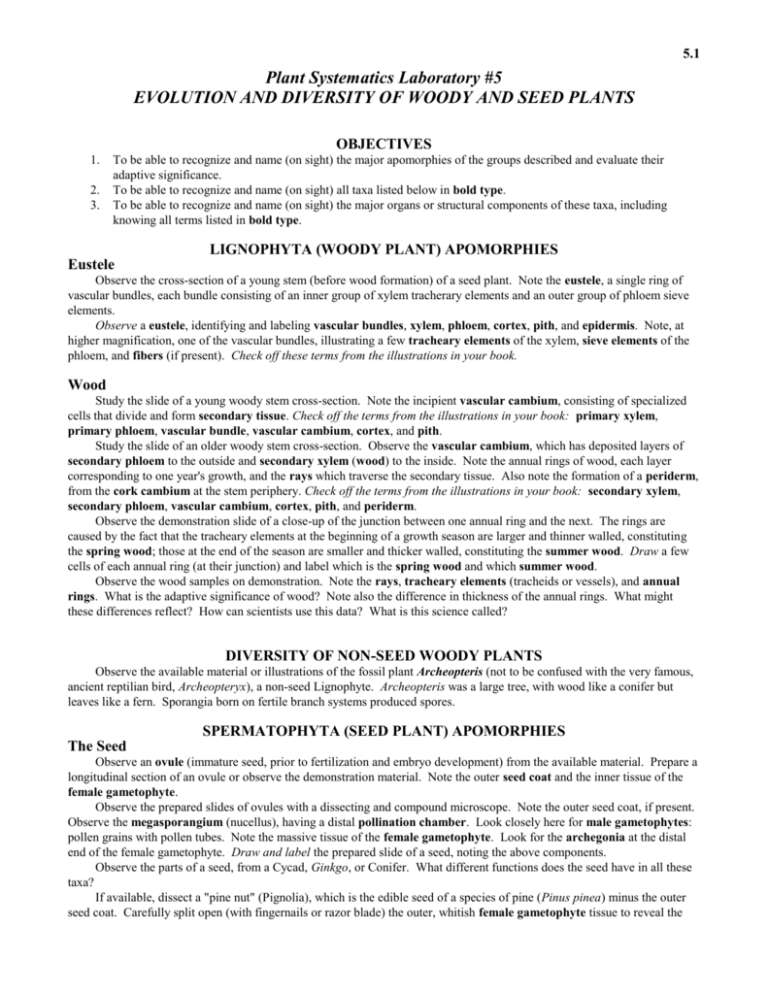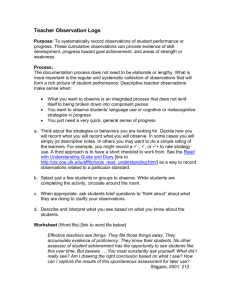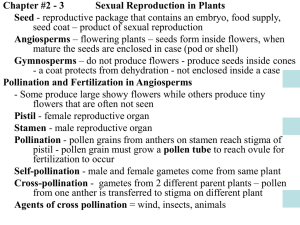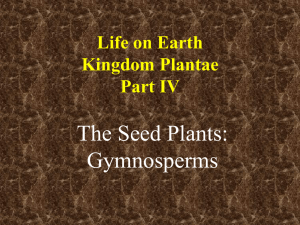Lab 5 - SDSU College of Sciences
advertisement

5.1 Plant Systematics Laboratory #5 EVOLUTION AND DIVERSITY OF WOODY AND SEED PLANTS OBJECTIVES 1. 2. 3. To be able to recognize and name (on sight) the major apomorphies of the groups described and evaluate their adaptive significance. To be able to recognize and name (on sight) all taxa listed below in bold type. To be able to recognize and name (on sight) the major organs or structural components of these taxa, including knowing all terms listed in bold type. LIGNOPHYTA (WOODY PLANT) APOMORPHIES Eustele Observe the cross-section of a young stem (before wood formation) of a seed plant. Note the eustele, a single ring of vascular bundles, each bundle consisting of an inner group of xylem tracherary elements and an outer group of phloem sieve elements. Observe a eustele, identifying and labeling vascular bundles, xylem, phloem, cortex, pith, and epidermis. Note, at higher magnification, one of the vascular bundles, illustrating a few tracheary elements of the xylem, sieve elements of the phloem, and fibers (if present). Check off these terms from the illustrations in your book. Wood Study the slide of a young woody stem cross-section. Note the incipient vascular cambium, consisting of specialized cells that divide and form secondary tissue. Check off the terms from the illustrations in your book: primary xylem, primary phloem, vascular bundle, vascular cambium, cortex, and pith. Study the slide of an older woody stem cross-section. Observe the vascular cambium, which has deposited layers of secondary phloem to the outside and secondary xylem (wood) to the inside. Note the annual rings of wood, each layer corresponding to one year's growth, and the rays which traverse the secondary tissue. Also note the formation of a periderm, from the cork cambium at the stem periphery. Check off the terms from the illustrations in your book: secondary xylem, secondary phloem, vascular cambium, cortex, pith, and periderm. Observe the demonstration slide of a close-up of the junction between one annual ring and the next. The rings are caused by the fact that the tracheary elements at the beginning of a growth season are larger and thinner walled, constituting the spring wood; those at the end of the season are smaller and thicker walled, constituting the summer wood. Draw a few cells of each annual ring (at their junction) and label which is the spring wood and which summer wood. Observe the wood samples on demonstration. Note the rays, tracheary elements (tracheids or vessels), and annual rings. What is the adaptive significance of wood? Note also the difference in thickness of the annual rings. What might these differences reflect? How can scientists use this data? What is this science called? DIVERSITY OF NON-SEED WOODY PLANTS Observe the available material or illustrations of the fossil plant Archeopteris (not to be confused with the very famous, ancient reptilian bird, Archeopteryx), a non-seed Lignophyte. Archeopteris was a large tree, with wood like a conifer but leaves like a fern. Sporangia born on fertile branch systems produced spores. SPERMATOPHYTA (SEED PLANT) APOMORPHIES The Seed Observe an ovule (immature seed, prior to fertilization and embryo development) from the available material. Prepare a longitudinal section of an ovule or observe the demonstration material. Note the outer seed coat and the inner tissue of the female gametophyte. Observe the prepared slides of ovules with a dissecting and compound microscope. Note the outer seed coat, if present. Observe the megasporangium (nucellus), having a distal pollination chamber. Look closely here for male gametophytes: pollen grains with pollen tubes. Note the massive tissue of the female gametophyte. Look for the archegonia at the distal end of the female gametophyte. Draw and label the prepared slide of a seed, noting the above components. Observe the parts of a seed, from a Cycad, Ginkgo, or Conifer. What different functions does the seed have in all these taxa? If available, dissect a "pine nut" (Pignolia), which is the edible seed of a species of pine (Pinus pinea) minus the outer seed coat. Carefully split open (with fingernails or razor blade) the outer, whitish female gametophyte tissue to reveal the 5.2 central, longitudinally-oriented embryo. With care, you can remove or expose the embryo intact. Observe the radical (attached to long, stringy suspensor cells), cotyledons (3-18 in Pine), and epicotyl (observed by removing some cotyledons). Draw and label the dissected Pine seed, noting the above components. Observe the prepared slide of a seed longitudinal section, noting the female gametophyte and embryo parts described above. Draw. DIVERSITY OF SEED PLANTS Fossil "Seed ferns" Observe the available material of the fossil seed ferns. "Seed ferns" are a paraphyletic (non-natural) group of fossil plants that had fern-like foliage, yet bore seeds. Medullosa is one example of a seed fern; note the fossil stems. As in many fossil plants, different organs of Medullosa are placed in separate "form genera." For example, the fern-like leaves of Medullosa are in the form genera Alethopteris and Neuropteris. Dolerotheca (having huge pollen grains) refers to the pollenbearing organs of Medullosa. Also note the fossil seed Pachytesta; both longitudinal and cross-sections are on display. Cycads (Cycadales) Cycads are a relatively ancient group of plants, now fairly restricted in distribution. None are native to our area, although many, especially Cycas circinalis, are planted horticulturally. Observe the potted specimens of cycads on display. Note the generally short, erect stem, lacking axillary branching (a possible apomorphy for the group). Stems bear spirally arranged, coriaceous (leathery), pinnately compound leaves (bipinnately compound in the tropical Australian Bowenia). Note that immature leaves have circinate vernation. Note the available reproductive material. All cycads are dioecious, either male or female. Each male cone (strobilus) has a central axis bearing microsporophylls, which bear microsporangia on the abaxial surface. The microsporangia form microspores, which develop into pollen grains. Draw and label a male cycad cone plus a close-up of a microsporophyll with microsporangia. Note female cones (strobili) with megasporophylls, each bearing two seeds. The genus Cycas itself is the only cycad that lacks cones, having large megasporophylls bearing several seeds. Draw and label a female cycad cone and/or Cycas megasporophyll plus a close-up of a megasporophyll with attached ovules or seeds. (If suitable material is available, try to observe motile (flagellate) sperm within cycad seeds.) Cycas (e. Africa to Japan & Australia) C. revoluta Sago-Palm commonly planted as outdoor ornamental; this species and others are a source of sago from pith (probably carcinogenic), used for flour & bread in India; C. media, seeds boiled, eaten by Australian Aborigines Dioon (Mexico & Central America) D. spinulosa; D. edule (Mexico) has edible seeds Encephalartos (trop. to s. Africa) Cultivated ornamental; stems a source of sago (starchy food) Macrozamia (Australia) Cultivated ornamental; seeds edible (e. g., Queensland Nut) Zamia (trop. & warm Americas) Cultivated ornamental; starch sources (toxic until boiled) Microcycas (Cuba) Monotypic (M. calocoma), endemic to Cuba, almost extinct; mis-named, as it tallest cycad, approaching palms in height (see photograph). Ginkgo (Ginkgoales) Observe the live and/or herbarium material of Gingko biloba. Ginkgo is native only to certain remote regions of China but has now been planted worldwide as a popular street tree. Note the short shoots (in addition to long shoots) and the distinctive obtriangular, apically 2-lobed leaves with dichotomous venation. Ginkgo, like the Cycads, is dioecious and has motile (flagellate) sperm that arise from the pollen grain after pollination. Draw, label, and learn to recognize a Ginkgo leaf and short shoot. Conifers (Coniferales) Pinaceae PINE FAMILY. Observe a pine branch. Note that the leaves of the main branch, the long shoot, are small, brownish, and often non-photosynthetic scale leaves. In the axil of each scale leaf occurs a modified lateral branch, known as a short shoot or fascicle. Each short-shoot or fascicle consists of stem tissue, one or more needle-shaped leaves, and persistent bud scales. Remember that the fascicle is a shoot system and will arise from an bud in the axil of a scale leaf. Draw and label a pine fascicle. Note the male cones of a pine, consisting of microsporophylls bearing microsporangia (little yellow sacs where pollen grains are produced). Draw and label a male cone and a close-up of a microsporophyll with microsporangia. If available, observe the male cone longitudinal-section and draw the same structures. Make a wet-mount of some pollen grains of pine and observe with a compound microscope. Draw and label a single pollen grains, noting the saccate morphology (appearing as a "mickey mouse" shape). What is the possible function of the saccate pollen grain morphology? 5.3 Female cones are determinate shoots consisting of a stem axis which bears ovuliferous scales, each ovuliferous scale subtended by a bract. The bracts are generally small but can get large, e.g., in Pseudotsuga (DOUGLAS-FIR). Each ovuliferous scale bears two ovules (which, of course, develop into two seeds) on its adaxial surface. Ovuliferous scales evolved from much more elaborate lateral branch systems, which became fused and flattened; this fertile shoot system constitutes a synapomorphy with the Ginkgoales. Pine seeds are often winged. When the female cones are closed, the outer exposed surface of the ovuliferous scale is called an apophysis; a raised portion of the apophysis is known as an umbo. The umbo often ends in a prickle. Note first year cones, second year cones, and mature cones that have released the seeds already. Observe the prepared slide of a pine female cone, noting ovule, ovuliferous scale, and bract. Draw and label. Pinaceae. Pine family. Draw and label parts of one female cone of a representative members: Pinus spp. Pines. Note the representative species of pines, including P. canariensis, P. coulteri, P. jeffreyi, P. monophylla, and P. torreyana. Note the species differences in the number, shape, and size of the leaves of the fascicle and differences in female cone morphology. Abies sp. Fir. Note the petiolate to subsessile, linear leaves of the Fir tree. The cones of Fir are erect. Picea sp. Spruce. Note the petiolate, linear leaves, which leave behind a characteristic peg-like leaf-scar. Pseudotsuga sp. Douglas-Fir. Note the petiolate, linear leaves. The female cones are pendant (hang down) and have elongate, trifid bracts. Cupressaceae Cypress family (including Taxodiaceae). Members of this family have characteristic small, triangular (awl-shaped) leaves, which are often (though not always) decussate and closely appressed to the stem. Calocedrus decurrens [Libocedrus decurrens] Incense-Cedar. A large tree of high altitude, coniferous forests (e.g., Cuyamaca, Laguna Mts. of S.D. Co.). Note that the minute, decussate leaves are decurrent along the highly branched and flattened stems. Chamaecyparis thyoides White Cedar, eastern U.S. Cupressus forbesii Tecate-Cypress Note the minute leaves and highly branched shoots of this somewhat rare species. The female cones are spherical with tightly closed ovuliferous scales bearing a raised umbo. Cupressus sempervirens var. stricta Italian-Cypress This commonly cultivated tree is tall and very narrow. Juniperus californica California Juniper. The junipers differ from the cypresses in having succulent, "berry-like" female cones, caused by a thickening and fusion of the ovuliferous scales. Metasequoia glyptostroboides Dawn Redwood Sequoia sempervirens Redwood Sequoiadendron giganteum Giant Sequoia Taxodium distichum Bald-Cypress Taxodium mucronatum Montezuma-Cypress Thuja occidentalis Eastern White Cedar, T. plicata Western Cedar. This genus can be recognized in part by the flattened branch systems. Araucariaceae. Members of this family are found in parts of South America, Australia, Oceania, and s.e. Asia. Araucaria bidwillii Bunya-Bunya, n. e. Australia Araucaria heterophylla Norfolk Island-Pine, Norfolk I., Australia Podocarpaceae. Members of this family have very reduced female cones, appearing as a single seed. Agathis sp. Podocarpus gracilior East African Fern Pine (tropical Africa) Podocarpus macrophyllus Japanese Yew Pine (Japan) Gnetales Ephedra sp. MORMON-TEA. Ephedra can be recognized by the photosynthetic, striate (longitudinally ridged) stems and the very reduced scale-like leaves, only 2 or 3 per node. (NOTE: Don't confuse with Equisetum; study the differences.) Male or female cones may be found in the axils of the leaves. Draw and learn to recognize. Welwitschia mirabilis WELWITSCHIA. Observe the live or preserved material (if available) and photographs of this weird plant native to deserts of Namibia (southwestern Africa). An underground caudex bears only two leaves, these becoming quite long and lacerated in old individuals. Male and female cones are born on axes arising from the apex of the caudex. Draw and learn to recognize. Gnetum. This plant is a tropical vine with opposite, simple leaves, looking all the world like an angiosperm but, of course, lacking true flowers. Observe photographs.









